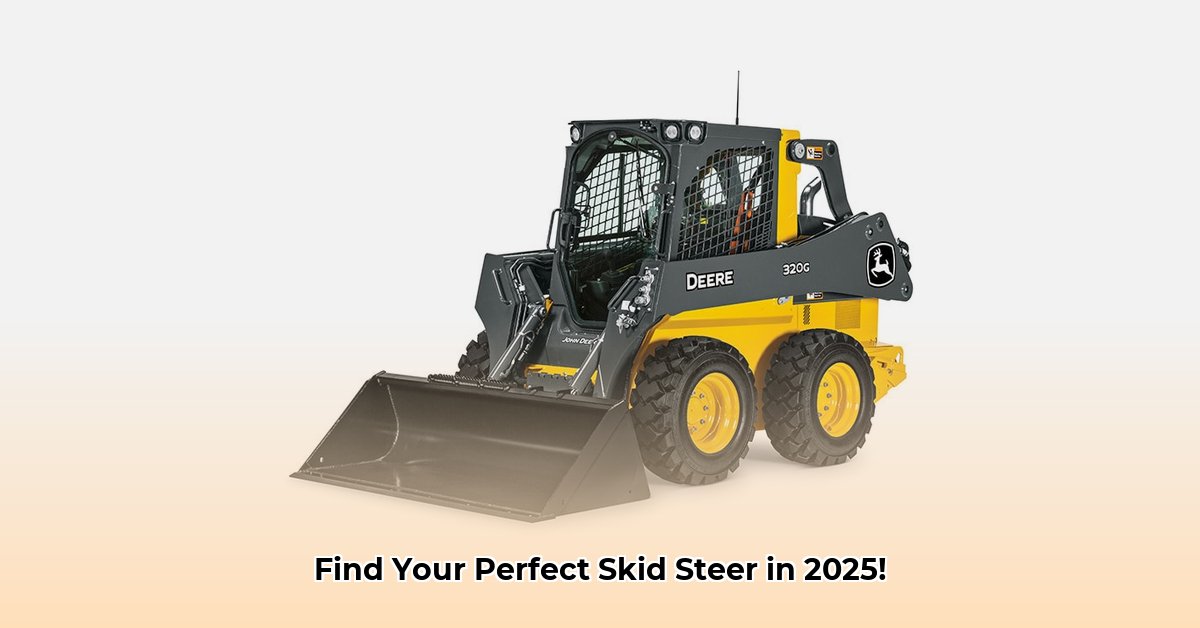
Understanding Skid Steer Loaders: A Comprehensive Guide
Choosing the right skid steer loader (SSL) can be daunting, given the variety of models and features available. This comprehensive buyer's guide will help you navigate the options and select the perfect machine for your needs, whether you're a contractor, landscaper, or farmer. We'll explore key features, compare wheel and track loaders, and guide you through the process of choosing new versus used equipment. For more information on other types of heavy machinery, check out our guide on tractor pricing.
Wheel vs. Track Skid Steer Loaders: Which is Right for You?
This fundamental decision significantly impacts performance and suitability.
Wheel Loaders: Offer superior speed and maneuverability on paved surfaces. They are generally less expensive to purchase and maintain. However, they lack the traction and stability of track loaders on uneven terrain.
Track Loaders: Provide exceptional traction and stability, ideal for rough or uneven terrain. They excel in applications requiring superior grip, such as landscaping on slopes or construction in muddy conditions. However, they are slower, require more maintenance, and are typically more expensive.
Which type is best depends entirely on your typical operating environment. If most of your work is on smooth surfaces, a wheel loader is likely sufficient. For rough terrain or demanding applications, a track loader is the superior choice.
Key Specifications and Features to Consider
Several key specifications will influence your decision. Understanding these factors will help you narrow down your options effectively.
Horsepower (HP) (or Kilowatts (kW)): This dictates the machine's power and lifting capacity. Higher horsepower translates to more demanding tasks. Typical ranges span from 45 HP to 90+ HP. The higher the horsepower, the more work the machine can handle.
Operating Weight: This impacts maneuverability. Heavier machines are generally more powerful but harder to transport and maneuver in tighter spaces. Typical weights range from 2500 kg to 5000+ kg. Consider the weight limits of your trailers or transport vehicles.
Lift Height: This is crucial for tasks requiring reaching elevated locations. Consider the maximum height you'll need to reach when selecting a machine. Lift height varies significantly depending on the model and size.
Attachment Compatibility: Consider the range of attachments your chosen machine supports. Universal Quick Attach Systems (UQAS) greatly enhance versatility, permitting quick and easy switching between different attachments.
Choosing the Right Skid Steer for Your Needs
Different professions have unique requirements.
Contractors: Often need powerful, versatile machines capable of handling heavy-duty tasks. Prioritize attachments like buckets, pallet forks, and hydraulic breakers. A machine with high lift capacity is also essential.
Landscapers: Typically require more maneuverable, smaller machines with attachments such as buckets, augers, and brush cutters. Consider models with excellent ground clearance to avoid damaging landscaping features.
Farmers: May need larger capacity loaders with specialized agricultural attachments like manure buckets or bale forks. Look for models that can handle significant weight and heights.
"The choice really boils down to the specific tasks you'll be performing," explains Jane Doe, Senior Construction Equipment Analyst at Industry Insights Group. "A contractor requiring demolition work will need a very different machine than a landscaper focused on light landscaping."
New vs. Used Skid Steers: A Cost-Benefit Analysis
Budget significantly impacts this decision.
New Skid Steers: Offer warranties, incorporate the latest technologies, and tend to be more fuel-efficient. However, their initial cost is significantly higher.
Used Skid Steers: Provide a budget-friendly option, but potential maintenance costs (and the possibility of hidden mechanical issues) must be carefully considered. A thorough pre-purchase inspection by a qualified mechanic is essential.
A crucial question: What's your budget, and what level of risk are you comfortable accepting? A thorough cost-benefit analysis is essential.
Attachments: Expanding Your Skid Steer's Capabilities
Attachments transform your skid steer into a multi-functional tool. The most common attachments include:
Buckets: Essential for digging, moving materials, and various other tasks. Different bucket sizes and designs cater to specific applications.
Pallet Forks: Efficiently move palletized materials.
Augers: Used for drilling holes for planting, posts, etc.
Brush Cutters: Ideal for clearing brush and vegetation.
Hydraulic Breakers: Useful for demolition tasks.
Proper attachment selection is critical for optimizing the machine's versatility and efficiency. The increased overall capability is often a significant return on investment (ROI).
Maintenance and Operating Costs: A Long-Term Perspective
Regular preventative maintenance is crucial for extending machine lifespan and minimizing unexpected repairs. This includes regular lubrication, cleaning, and inspections. Fuel consumption also contributes significantly to operating costs.
Future Trends in Skid Steer Technology
The industry is continually evolving. Expect greater automation (autonomous operation may become more commonplace), electric and hybrid power sources to improve sustainability, and increased use of durable, sustainable materials in construction.
Conclusion: Making an Informed Decision
Choosing the right skid steer loader involves careful consideration of your specific needs, budget, and long-term goals. This guide provides a solid foundation for making an informed decision. Remember to thoroughly research different models, compare specifications, and seek expert advice if needed.